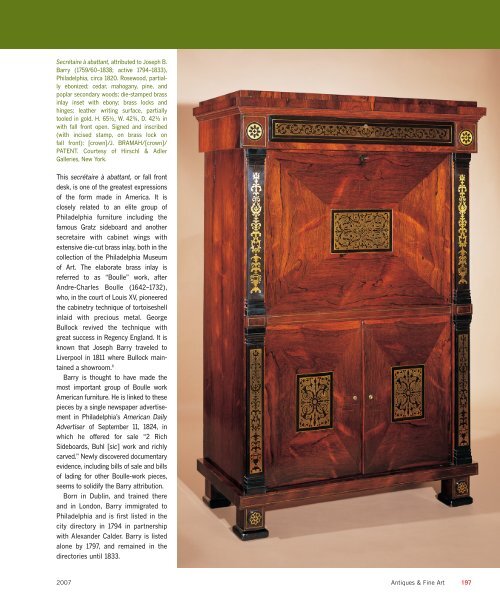by carswell rush berlin - Antiques and Fine Art
by carswell rush berlin - Antiques and Fine Art
by carswell rush berlin - Antiques and Fine Art
Create successful ePaper yourself
Turn your PDF publications into a flip-book with our unique Google optimized e-Paper software.
Secrétaire à abattant, attributed to Joseph B.<br />
Barry (1759/60–1838; active 1794–1833),<br />
Philadelphia, circa 1820. Rosewood, partially<br />
ebonized; cedar, mahogany, pine, <strong>and</strong><br />
poplar secondary woods; die-stamped brass<br />
inlay inset with ebony; brass locks <strong>and</strong><br />
hinges; leather writing surface, partially<br />
tooled in gold. H. 65˙, W. 42ƒ, D. 42˙ in<br />
with fall front open. Signed <strong>and</strong> inscribed<br />
(with incised stamp, on brass lock on<br />
fall front): [crown]/J. BRAMAH/[crown]/<br />
PATENT. Courtesy of Hirschl & Adler<br />
Galleries, New York.<br />
This secrétaire à abattant, or fall front<br />
desk, is one of the greatest expressions<br />
of the form made in America. It is<br />
closely related to an elite group of<br />
Philadelphia furniture including the<br />
famous Gratz sideboard <strong>and</strong> another<br />
secretaire with cabinet wings with<br />
extensive die-cut brass inlay, both in the<br />
collection of the Philadelphia Museum<br />
of <strong>Art</strong>. The elaborate brass inlay is<br />
referred to as “Boulle” work, after<br />
Andre-Charles Boulle (1642–1732),<br />
who, in the court of Louis XV, pioneered<br />
the cabinetry technique of tortoiseshell<br />
inlaid with precious metal. George<br />
Bullock revived the technique with<br />
great success in Regency Engl<strong>and</strong>. It is<br />
known that Joseph Barry traveled to<br />
Liverpool in 1811 where Bullock maintained<br />
a showroom. 8<br />
Barry is thought to have made the<br />
most important group of Boulle work<br />
American furniture. He is linked to these<br />
pieces <strong>by</strong> a single newspaper advertisement<br />
in Philadelphia’s American Daily<br />
Advertiser of September 11, 1824, in<br />
which he offered for sale “2 Rich<br />
Sideboards, Buhl [sic] work <strong>and</strong> richly<br />
carved.” Newly discovered documentary<br />
evidence, including bills of sale <strong>and</strong> bills<br />
of lading for other Boulle-work pieces,<br />
seems to solidify the Barry attribution.<br />
Born in Dublin, <strong>and</strong> trained there<br />
<strong>and</strong> in London, Barry immigrated to<br />
Philadelphia <strong>and</strong> is first listed in the<br />
city directory in 1794 in partnership<br />
with Alex<strong>and</strong>er Calder. Barry is listed<br />
alone <strong>by</strong> 1797, <strong>and</strong> remained in the<br />
directories until 1833.<br />
2007 <strong>Antiques</strong> & <strong>Fine</strong> <strong>Art</strong> 197




